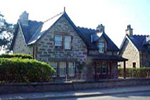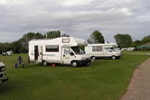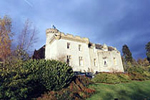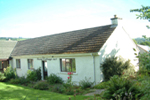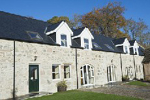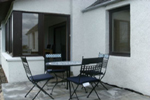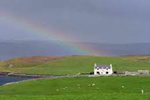A Friendly Welcome to Dingwall Scotland
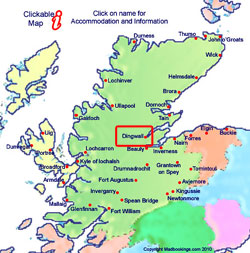 Dingwall
is the County Town of Ross and Cromarty, a mere 12 miles away from the
City of Inverness. Sitting at the head of the Cromarty Firth, Dingwall
was made a Royal Burgh in 1226 and is an excellent base from which to
visit many of the interesting parts of the east coast, the Black Isle
and - to the west - the glens of the central Highlands. Dingwall
is the County Town of Ross and Cromarty, a mere 12 miles away from the
City of Inverness. Sitting at the head of the Cromarty Firth, Dingwall
was made a Royal Burgh in 1226 and is an excellent base from which to
visit many of the interesting parts of the east coast, the Black Isle
and - to the west - the glens of the central Highlands.
Variety of Shops
Dingwall has the benefit of free parking and has ample parking space within
easy reach of the High Street. The majority of the High Street is pedestrianised
making the area an ideal place to enjoy a wide variety of shops. These
range from speciality shops, clothing shops, essential food stores, chemists,
a post office to banks and newsagents. Dingwall also boasts three high
quality butcher shops. In addition there are major super-markets and a
weekly auction room. A Shopmobility scheme operates in the town centre
to make life easy for anyone requiring access to local shops and facilities.
Places to Eat
There are many places to eat in the town ranging from quick take-away
food right through to quality hotel cuisine. Not only are all tastes catered
for, including Indian and Chinese, but thereare also an abundance of cafes
from the Railway Station to the High Street.
Monthly Farmer's Market
A highly successful Farmer's Market is regularly held in the
High Street on the second Saturday of each month.
Accommodation in and around Dingwall
Price Guide - per person based on sharing room:  under $40 -
under $40 -  $41
- 70 - $41
- 70 -  more than
$70 more than
$70
Things to Do
There is a new library which opened in the new Academy this year. Over
in Tulloch Street the Community Centre and the Gaelic Resource Centre,
both provide good specialised facilities.
A park, boating pond, tennis courts and children's play area provide a
pleasant, tranquil setting for relaxation for all ages, situated alongside
the River Peffery.
There is also a first-class caravan park on the eastern side of the Town,
close to the Ross County football ground, home to a thriving and successful
Scottish League club. Just by the ground is an all-weather pitch which
is available to all the community.
At the end of Ferry Road is an excellent water-side picnic site with wonderful
views down the Firth and of the mountains to the north and west. From
the rail station you can travel to Thurso in the north and Kyle of Lochalsh
in the west.
Full Range of Leisure Facilities
The Leisure Centre, located near to the Academy, has a large heated swimming
pool, a range of extensive modern fitness equipment and a large games
hall providing facilities for fitness classes, gymnastics, hockey, judo,
football and badminton. The Puffin Hydrotherapy Pool also adds to the
town's facilities and is situated just behind the Hospital in Ferry Road.
Golfers may wish to visit the nearby Strathpeffer 18-hole course which
lies in a wonderful hilly setting just 5 miles (8 km.) to the west.
Walks Around Dingwall
Canal and Firth
This is a pleasant walk along the banks of the Canal and the shores of
the Cromarty Firth. It is about 3 miles in length and takes about 1 1/2
hours.
Starting at the river bridge in Tulloch Street, follow the waymarkers
along the canal bank for Ferry Picnic Site and Pitglassie. Beyond the
railway crossing, tree-lined paths run along both sides of the Canal to
the Ferry Picnic Site.
Here there are excellent views out over the Cromarty Firth and the Conon
River estuary. The path continues inland from the Picnic Site along the
edge of the estuary.
This can be a good place for spotting wintering wild fowl such as greylag
geese, widgeon and goldeneye. The path allows you to turn away from the
estuary and head towards Pitglassie Farm. See map below - the route is
marked in green.
This route climbs via Craig Wood to visit Tulloch Castle, overlooking
the Town, and returns via Tulloch Wood. It is about 3 1/2 miles long and
takes about 2 hours
Follow Craig Road out of Town on the northbound A862. Beyond the houses
on the left, the first waymarker indicates the path for Craig Wood. The
path passes through lovely woodland before beginning to climb quite steadily.
Running up the Dingwall side of a deep gully, you eventually get great
views over the Town and the Cromarty Firth towards the Black Isle. At
the top of Craig Wood, the route crosses the road to Evanton (beware of
traffic!) and then heads left for Tulloch Farm and the Castle, which is
now a popular hotel and conference centre.
The path continues beyond the castle on an old tree-lined drive. Follow
the waymarkers for the Town centre which take you back down through Tulloch
Wood to Bridgend Avenue and Tulloch Avenue. See map below - the route
is marked in red.
To Knockfarrel and Fodderty (3)
This is a pleasant walk up through farmland to the crofting settlement
on the south side of Knockfarrel, the site of an Iron Age fort, returning
via Fodderty and Brae Farm. It is about 5 1/2 miles in length and takes
about 2 1/2 hours.
Follow the A834 west along the High Street until it bears sharp right.
Here take the left junction, Knockbain Road, up the hill and follow the
waymarkers for Knockfarrel and Strathpeffer. The road goes past Knockbain
Farm and out on to open countryside. Further on there are excellent views
over Dingwall to the Cromarty Firth. The path eventually joins the small
road running through the crofting settlement of Knockfarrel overlooking
Loch Ussie - a haven for wildlife.
The hill of Knockfarrel was the site of a 3,000-year-old Iron Age fort
and you can still see the vitrified wall where stones were melted together
by fire to create strong ramparts. From the summit there are wonderful
panoramic views in all directions. From Knockfarrel the return route back
to Dingwall takes you via Fodderty, Brae Farm and Lower Dochcarty. See
map below the route is marked in blue.
Here in Easter Ross and The Black Isle....
Using Dingwall as your base, there is a wealth of places to visit
in the surrounding area. The map on the right shows the surrounding area
- just click on the image to see a larger scale map.
Victorian Strathpeffer
Strathpeffer is a Victorian Spa town and the healing waters can still
be tasted in the recently renovated Pump Room. There is also the Highland
Museum of Childhood in the old station building. This is open from March
to October and, with a tearoom next door, makes an interesting afternoon
visit.
Unique Beauty
To the west of Strathpeffer is Strathconon, another wonderful Highland
glen with its own unique beauty and recently the subject of a television
series.
Northwest of Strathpeffer are the spectacular Rogie Falls, and a walk
down into the ravine and across the suspension bridge can be a perfect
way to round off the day.
Beauly Priory
To the south, some six miles away, is Muir of Ord, home of the Glen Ord
Distillery. Makers of an excellent 12 year old Single Malt, they have
a visitor centre open most of the year and guided tours are available.
At nearby Beauly are the ruins of the old Priory, and on the outskirts
of this attractive town is the Made in Scotland Craft Shop. This may provide
an opportunity to purchase a gift not available elsewhere.
Just beyond Beauly, a right turn sees the road head off west towards Struy
and Cannich and some of the most wonderful scenery in the Highlands. Glen
Affric, beyond Cannich, is quite magnificent and provides ample opportunities
for walking along the river and up into the hills. Further north, Glen
Strathfarrer provides the same facilities in similarly wonderful scenery.
Seal Colony
To the north-east beyond the Ardullie roundabout, on the main A9 trunk
road, is an excellent viewpoint to see the local seal colony.
A further 4 1/2 miles to the north-east is Alness, a town which takes
great pride in its appearance. Very recently it won the Britain in Bloom
and Beautiful Scotland in Bloom competitions. On the outskirts of Alness
is the Dalmore Distillery which has a visitor centre and guided tours.
Invergordon
Invergordon
Overlooking Alness is the monument on Fyrish Hill - a replica of a gateway
to a town in India captured by a local General in 1781. Its construction
provided work at a time of local unemployment in the area. The car park
at the base of the hill is an ideal starting point, and a climb to the
top, to enjoy the wonderful panoramic views, and back takes about 2 1/2
hours.
Tremendous History
Invergordon, just beyond Alness, is a town with a tremendous military
history stretching back through two world wars and now a centre for oil-rig
refurbishment and maintenance. It is also a major port of call for cruise
liners.
Fine Single Malt
To the north-east is Tain and the Seaboard villages of Balintore and Portmahomack
on the Fearn Peninsula. Just outside Tain is the Glenmorangie Distillery,
makers of some of the finest single malt whiskies in the world. The visitor
centre is open every weekday and guided tours are available.
Tain claims to be Scotland's oldest Royal Burgh with a charter that dates
back to 1066. As the birthplace of St. Duthac, the town was an important
destination for pilgrims, and St. Duthac's chapel and surrounding buildings
are part of the 'Tain through Time' guided tour - well worth a visit.
Balintore is one of the driest and sunniest places in Britain, and offers
pleasant walks along the foreshore. Boats are available in the harbour
for charter which can be used for sea angling.
Coastal Walks
Portmahomack, on the other side of the Fearn Peninsula, attracts people
who enjoy sailing and sailboarding. There are also wonderful coastal walks
to Tarbat Ness where the lighthouse is the second highest in Britain.
The Black Isle, reached by crossing the Cromarty Firth by the bridge at
Ardullie, or via the ferry from Nigg, has many places of interest. At
Cromarty, The Courthouse, Parish Church and Hugh Miller's Cottage are
just some of the places to visit in this historic and picturesque coastal
village.
History of the Picts
Some 12 miles (19km) from Cromarty is Rosemarkie, a town with wonderful
beaches and excellent coastal walks with views across the Moray Firth.
The town also houses the Groam House Museum which provides a history of
the ancient inhabitants of the north, the Picts. To the north of the town
is a lovely inland walk up Fairy Glen on the banks of the local river.
At nearby Fortrose is the 14th century Cathedral, and between Rosemarkie
and Fortrose is Chanonry Point, site of another lighthouse, and a viewpoint
- in the right weather conditions - of the local Dolphin population.
Near Munlochy is the Black Isle Wildlife and Country Park, an ideal entertainment
for all the family.
Warm Welcome
This is just a taste of the many places you can visit in the area and
it is certain that the warm welcome you have received in Dingwall will
be repeated in any of the places you choose to visit here, in Easter Ross
and the Black Isle...
History of Dingwall A Bríef History
of Dingwall by David MacDonald
Dingwall owes its place-name to Norwegian Vikings who ruled northern
Scotland from about the end of the ninth century AD. Dingwall, at the
sheltered head of the Cromarty Firth and a place from which the west coast
could be reached by way of easy overland routes along the river valleys,
became a significant place of Viking administration and decision making.
In Norse the name Dingwall means meeting place.
Positioned on the frontier between Norse held northern Scotland and the
kingdom of the Scots, Dingwall was fought over by both sides. It is believed
that during one of the periods it was in the hands of the Scots Dingwall
was where Macbeth was born in 1005.
It is thought that the town of Dingwall was first created by the Norse
Earl Thorfinn the Mighty round about 1050.
Control of the area by the Scottish Kings was not finally achieved until
about 1200. In 1226 King Alexander II erected Dingwall into a royal burgh
with trading rights throughout Scotland and overseas. The layout of the
old town centre is recognisably medieval. There are still buildings gable-ended
to the High Street with narrow lanes (locally termed closes or courts)
running between them.
The fortress at Dingwall, probably first established by the Norse, became
one of the thirty royal castles of the Scottish kingdom. During the War
of Independence the Castle was garrisoned by the forces of Edward I of
England. It was captured for Robert Bruce by William, Earl of Ross. From
the Castle in 1314 the Earl led the men of Ross to play their part in
the Battle of Bannockburn. In reward King Robert in 1321 granted the Castle
with the town and lands of Dingwall to the Earl of Ross.
The Castle became the main residence of the Earl of Ross, who met with
the lords of his council on the moothill of Dingwall, just as earlier
the Viking Earl and his chieftains had done.
In 1411 Angus, Lord of the Isles, unsuccessfully sought to win his claim
to the earldom by seizing Dingwall Castle. Eventually in 1438 Alexander,
Lord of the Isles, was recognised as Earl of Ross.
Alexander settled in Dingwall where he lived as a great prince. From
there, as one of the two Justiciars of Scotland, he ruled the whole of
Scotland north of the Tay. His son John was not as successful. He unwisely
made a secret treaty with Edward IV of England to share Scotland between
them. When James III, King of Scots, discovered the existence of that
treaty, he had the earldom confiscated in 1475. Ever since, the second
son of the monarch has held the title of Earl of Ross. The Castle and
the burgh again became royal possessions.
Favoured by the Crown, the power of Clan Mackenzie spread throughout
Ross. No longer needed for control of Ross, the Castle of Dingwall was
abandoned by the Crown about 1600. The Castle slowly fell into ruin and
was used as a quarry until it was finally levelled in 1817, leaving visible,
but few, fragments.
With administration of Ross no longer centred on Dingwall Castle the
town after 1600 slipped into a state of poverty, but clung on to its status
as a royal burgh. Events in the eighteenth century brought the beginnings
of a revival in the town’s fortunes.
The 1707 Treaty of Union ended a Parliament in Edinburgh, but maintained
Dingwall’s right to play a part in the sending of a member to the
United Kingdom Parliament at Westminster. Each of the northern Scottish
royal burghs – Dingwall, Tain, Dornoch, Wick, Thurso and Kirkwall
– had one vote in the election of an MP to represent all five of
them. Dingwall town council became notorious for accepting bribes in return
for its vote. In 1730 money for that vote was used to build Dingwall’s
Town House. By the same means in 1774 Dingwall built its first town clock
on the central tower of the Town House. It stood there until 1906, when
the present clock tower, a near-replica of the first, was erected.
Feuding between Mackenzies and Munros for Dingwall’s parliamentary
vote led at times to violent riots on Dingwall High Street. In 1740 the
wife of a Mackenzie councillor was fatally shot when Munro troops opened
fire along the High Street.
In 1745 the Provost of Dingwall, the Earl of Cromartie, led his Mackenzie
clansmen out in rebellion to join with Prince Charles Edward Stewart.
Defeat of the Jacobites at Culloden brought an end to clan violence. In
its work of bringing a new order to Ross the Sheriff Court at Dingwall
became one of the busiest in Scotland. Defending illicit distillers and
smugglers made Dingwall lawyers both prosperous and unusually numerous
for a small town.
Towards 1800 agricultural changes created commercial farming and much
increased consequent business to the market town. The construction of
parliamentary, or Telford, roads in the early nineteenth century made
Dingwall the busiest route centre in Northwest Scotland. In 1843 Dingwall,
the road centre of Ross, gained full recognition as County Town.
In 1817 a canal was excavated to bring larger ships into the town. The
Dingwall designer and builder of the canal ignored Telford’s advice
that, to avoid silting, the River Peffery should not flow through it.
In 1840 use of the mudded Canal was abandoned.
Railways made Dingwall the key northern Scotland junction, leading to
its further growth as an agricultural market and retail centre. Permanent
livestock markets were established in the town about 1890. In 2003 these
marts relocated to modern premises and freed an extensive town centre
site for a large superstore.
Following the South African War of 1899-1902 and then the Great War of
1914-18 three striking memorial monuments were erected. They remain prominent
landmarks in the town centre. An impressive stone tower erected in 1907
in commemoration of a local hero, “Fighting Mac”, Major-General
Sir Hector MacDonald, from its hilltop site looks northwards over the
town. |
![]() Email enquiries & reservations: bookscotland@madbookings.com
Email enquiries & reservations: bookscotland@madbookings.com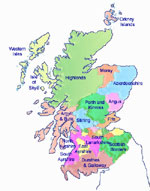
 Dingwall
is the County Town of Ross and Cromarty, a mere 12 miles away from the
City of Inverness. Sitting at the head of the Cromarty Firth, Dingwall
was made a Royal Burgh in 1226 and is an excellent base from which to
visit many of the interesting parts of the east coast, the Black Isle
and - to the west - the glens of the central Highlands.
Dingwall
is the County Town of Ross and Cromarty, a mere 12 miles away from the
City of Inverness. Sitting at the head of the Cromarty Firth, Dingwall
was made a Royal Burgh in 1226 and is an excellent base from which to
visit many of the interesting parts of the east coast, the Black Isle
and - to the west - the glens of the central Highlands.